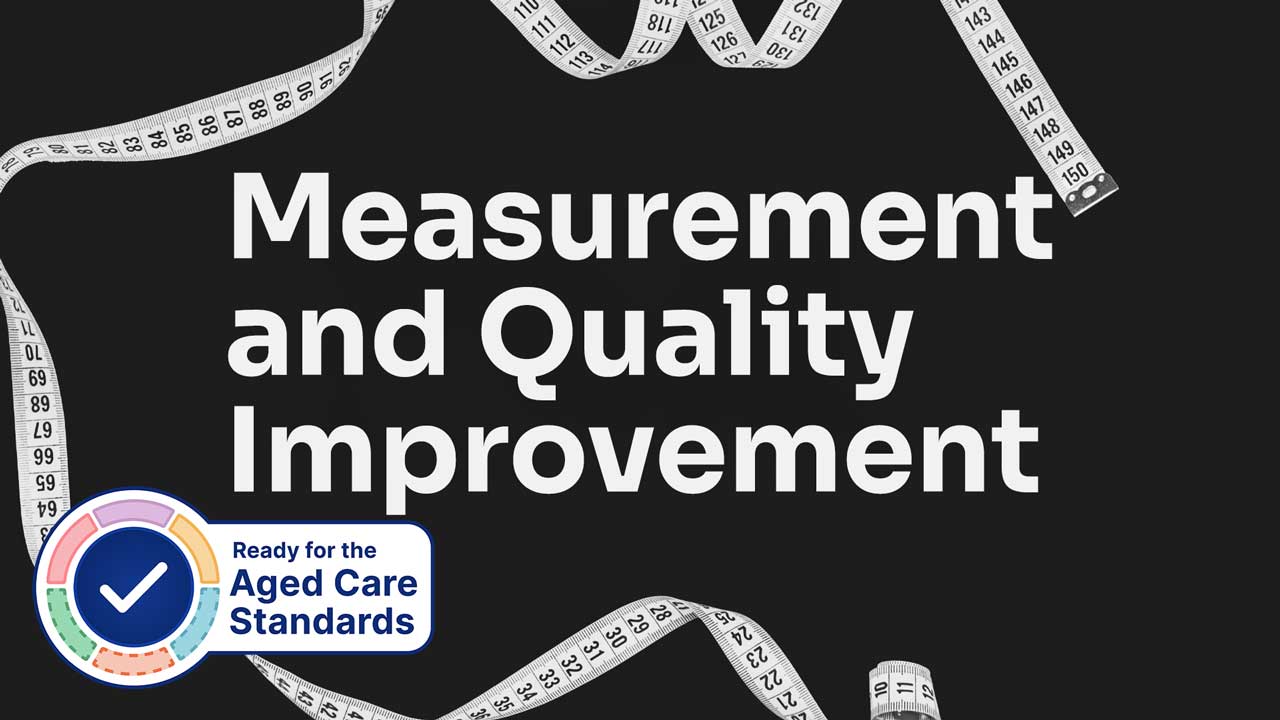Quality. It’s something we all strive for. It’s the optimum level of care experienced by patients.
‘Measurement and quality improvement’ is the second component of Patient Safety and Quality Systems, as outlined by the National Safety and Quality Health Service Standards: Standard 1 Clinical Governance.
Why do We Have Patient Safety and Quality Systems?
As part of the governance process of a health service, patient safety and quality systems are created to advance the safety and the quality of patients’ care (ACSQHC 2022a).
The intent of measurement and quality improvement is to implement effective quality improvement systems that operate across the entire organisation (ACSQHC 2021).
The public’s perception of quality in healthcare has assessable consequences. There is growing evidence to indicate that people will avoid using services they deem as lacking in quality (Hanefeld et al. 2017) and that this is ‘a barrier to universal health coverage’, regardless of physical access to care (Berendes et al. 2011).

How Do You Define ‘Quality’?
According to the American Institute of Medicine, quality in a healthcare context is ‘the degree to which healthcare services for individuals and populations increase the likelihood of desired health outcomes and are consistent with current professional knowledge’ (Institute of Medicine, as cited in AHRQ 2020a).
Why do We Measure?
Regular measuring of a system is essential to ensuring quality improvements. It allows a facility to determine the baseline level of current operational performance; establish goals for future performance; and monitor the impact of changes as they are made (AHRQ 2020b). When measured properly, metrics can guide every decision made to ultimately improve the end product, in this case, patient care.
Measurement and Quality Improvement Under the Strengthened Aged Care Quality Standards
Standard 2: The Organisation - Outcome 2.3: Accountability and quality systems of the strengthened Aged Care Quality Standards highlights the importance of maintaining a quality system that facilitates the continuous improvement of care and services (ACQSC 2024).
- Action 2.3.1 (d) requires the organisation’s governing body to implement a quality system that monitors the organisation’s performance in providing high-quality care and services
- Action 2.3.3 requires providers to review and improve their quality system routinely
- Action 2.3.4 requires providers to report on their quality system’s performance routinely.
(ACQSC 2024)
What is the First Step to Measuring Quality?
To be able to determine whether goals have been met, it’s first necessary to define the desired end outcome. Without a clear goal established from the very start, it’s difficult to measure and recognise whether the changes that were made have resulted in improvements - or if they are just changes (Health Quality Ontario 2013).
Create a Measurement Plan
A measurement plan should contain the following (at a minimum):
- A name
- The measurement type
- Why it’s needed
- The method of data collection and sampling
- And these questions:
- How will the data be displayed and communicated?
- Has baseline data been gathered?
- Is there a set goal?
(Health Quality Ontario 2013)
The plan must be reviewed frequently. Rather than displaying data in a standard pre/post-implementation way, plot the data over time (for example, by month) for a clearer picture of how the changes are affecting outcomes. This process should be actively shared with staff to create momentum on an organisation-wide scale (Health Quality Ontario 2013).

Quality Measurement Tools
An effective quality measurement tool must:
- Be reliable (the tool should have the same outcome regardless of who is measuring)
- Be objective
- Be valid and reliable
- Be standardised
- Be evidenced-based
- Not affect or distort results.
(AHRQ 2020a)
Examples of what could be measured for quality improvement within a healthcare facility include:
- The time lapsed between transfer from the emergency department (ED) to an inpatient bed
- The presence (or absence) of quality improvement programs
- The number of nurses to the number of patients.
(AHRQ 2020a; Health Quality Ontario 2013)
Measurement Challenges
Six important considerations for designing measurement systems are:
- A patient’s experience of quality must be conceptualised as taking place over time; it is not stagnant.
- Responsiveness to the patient is a key aspect of quality.
- Broad factors such as the governance and management of a facility are likely to greatly influence quality.
- Quality can be considered as a construct driven by many different factors.
- Acknowledge that perceptions of the quality of care are an important factor of care utilisation, regardless of whether these perceptions are accurate.
- Approaches should be adapted to manage measurement challenges as they arise.
(Hanefeld et al. 2017)
Measurement and Quality Improvement in an Australian Context
The presence of measurement and quality improvement in the NSQHS Standards implies its importance and represents a gap present in Australian facilities and services. The NSQHS Standards identify two missions for facilities in terms of measurement and quality improvement:
1. The health service organisation should use organisation-wide quality improvement systems that:
- Determine safety and quality measures, and monitor and report performance and outcomes
- Determine areas for improvement in safety and quality
- Implement and monitor strategies for improving safety and quality
- Engage with consumers and the workforce to review safety and quality performance and systems.
(ACSQHC 2022b)
2. The organisation must ensure that timely reports on safety and quality systems and performance are provided to the following four parties:
- The governing body
- The workforce
- Consumers/patients and the local community
- Any other relevant health service organisations.
(ACSQHC 2022c)

Conclusion
To up-scale health interventions, it’s necessary for facilities to recognise the multifaceted nature of quality of care. Technical quality must be increased, but equally crucial is better acceptability and a shift toward greater patient-centred care (Hanefeld et al. 2017).
The outcomes of care quality improvement should be tailored specifically to the needs of the community the facility exists in.
Test Your Knowledge
Question 1 of 3
Which one of the following is criteria for an effective measurement tool?
Topics
References
- Aged Care Quality and Safety Commission 2024, Standard 2: The Organisation, Australian Government, viewed 15 April 2024, https://www.health.gov.au/resources/publications/strengthened-aged-care-quality-standards-august-2025?language=en
- Agency for Healthcare Research and Quality 2020a, Understanding Quality Measurement, U.S. Department of Health and Human Services, viewed 15 April 2024, https://www.ahrq.gov/patient-safety/quality-resources/tools/chtoolbx/understand/index.html
- Agency for Healthcare Research and Quality 2020b, Uses of Quality Measurement, U.S. Department of Health and Human Services, viewed 15 April 2024, https://www.ahrq.gov/patient-safety/quality-resources/tools/chtoolbx/uses/index.html
- Australian Commission on Safety and Quality in Health Care 2021, National Safety and Quality Health Service Standards, 2nd edn, Australian Government, viewed 15 April 2024, https://www.safetyandquality.gov.au/publications-and-resources/resource-library/national-safety-and-quality-health-service-standards-second-edition
- Australian Commission on Safety and Quality in Health Care 2022b, Action 1.08, Australian Government, viewed 15 April 2024, https://www.safetyandquality.gov.au/standards/nsqhs-standards/clinical-governance-standard/patient-safety-and-quality-systems/action-108
- Australian Commission on Safety and Quality in Health Care 2022c, Action 1.09, Australian Government, viewed 15 April 2024, https://www.safetyandquality.gov.au/standards/nsqhs-standards/clinical-governance-standard/patient-safety-and-quality-systems/action-109
- Australian Commission on Safety and Quality in Health Care 2022a, Patient Safety and Quality Systems, Australian Government, viewed 15 April 2024, https://www.safetyandquality.gov.au/standards/nsqhs-standards/clinical-governance-standard/patient-safety-and-quality-systems
- Berendes, S, Heywood, P, Oliver, S & Garner, P 2011, ‘Quality of Private and Public Ambulatory Health Care in Low and Middle Income Countries: Systematic Review of Comparative Studies’, PLoS Med., vol. 8, no. 4, viewed 15 April 2024, https://journals.plos.org/plosmedicine/article?id=10.1371/journal.pmed.1000433
- Hanefeld, J, Powell-Jackson, T & Balabanova, B 2017, ‘Understanding and Measuring Quality of Care: Dealing with Complexity’, Bull World Health Organ., vol. 95, no. 5, viewed 15 April 2024, https://www.ncbi.nlm.nih.gov/pmc/articles/PMC5418826/
- Health Quality Ontario 2013, Measurement for Quality Improvement, Health Quality Ontario, viewed 22 October 2019, http://www.hqontario.ca/Portals/0/Documents/qi/qi-measurement-primer-en.pdf
 New
New 
